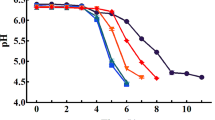Abstract
Limited hydrolysates ranging from 6.82 to 16.74 % degree of hydrolysis (DH) were produced from palm kernel expeller protein (PKP) using Alcalase. The nutritional value, physicochemical and functional properties of PKP and the hydrolysates, especially effects of DH, pH, ionic strength and temperature on these properties were studied. Results showed that all the hydrolysates showed higher nutritive value, better thermal stability and solubility (70.68–99.13 g/100 g) than PKP. The surface hydrophobicity, emulsifying properties and foaming activity were improved by limited enzymatic hydrolysis (DH: 6.82 to 11.72 %), whereas the foam stability, viscosity, water and oil holding capacity were negatively correlated with DH. Increase in ionic strength (from 0 to 0.4 mol/L) or temperature (from 30 to 50 °C) enhanced the solubility, emulsifying properties and foaming activity. But high temperature remarkably weakened the foaming properties and viscosity. Solubility, surface hydrophobicity and molecular weight influenced the emulsifying and foaming properties. PKP and the hydrolysates were good protein source.







Similar content being viewed by others
References
Adler-Nissen J (1979) Determination of the degree of hydrolysis of food protein hydrolysates by trinitrobenzenesulfonic acid. J Agric Food Chem 27:1256–1262
Agyare KK, Addo K, Xiong YL (2009) Emulsifying and foaming properties of transglutaminase−treated wheat gluten hydrolysates as influenced by pH, temperature and salt. Food Hydrocoll 23:72–81
Alimon AR (2005) The nutritive value of palm kernel cake for animal feed. Palm Oil Dev 40:12–14
Angelia MRN, Garcia RN, Caldo KMP, Prak K, Utsumi S, Mendoza EMT (2010) Physicochemical and functional characterization of cocosin, the coconut 11S globulin. Food Sci Technol Res 16:225–232
AOAC (1990) Official methods of analysis, 15th edn. Association of Official Analytical Chemists, Arlington
Arifin B, Bono A, Farm YY, Ling ALL, Fui SY (2009) Protein extraction from palm kernel meal. J Appl Sci 9:2996–3004
Bradford M (1976) A rapid and sensitive method for the quantitation of microgram quantities of protein utilizing the principle of protein dye binding. Anal Biochem 72:248–254
Chee KL, Ling HK, Ayob MK (2012) Optimization of trypsin−assisted extraction, physicochemical characterization nutritional qualities and functionalities of palm kernel cake protein. LWT - Food Sci Technol 46:419–427
Clemente A, Vioque J, Sánchez-Vioque R, Pedroche J, Bautista J, Millán F (1999) Protein quality of chickpea (Cicer arietinum L.) protein hydrolysates. Food Chem 67:269–274
Damodaran S (2005) Protein stabilization of emulsions and foams. J Food Sci 70:54–66
Dubois M, Gilles KA, Hamilton JK, Rebers PA, Smith F (1956) Colorimetric method for determination of sugars and related substances. Anal Chem 8:350–356
FAO/WHO (Expert consultation) (1990) Protein quality evaluation. FAO/WHO nutrition meetings, vol 51, Report Series. Food and Agricultural Organization/World Health Organization, Rome
Laemmli UK (1970) Cleavage of structural proteins during the assembly of the head bacteriophage T4. Nature 227:680–685
Liu Q, Kong BH, Xiong YL, Xia XF (2010) Antioxidant activity and functional properties of porcine plasma protein hydrolysate as influenced by the degree of hydrolysis. Food Chem 118:403–410
Morcillo F, Aberlenc-Bertossi F, Trouslot P, Hamon S, Duval Y (1997) Characterization of 2S and 7S storage proteins in embryos of oil palm. Plant Sci 122:141–151
Ng KL, Mohd KA (2012) Enzymatic preparation of palm kernel expeller protein hydrolysate (PKEPH). Int Food Res J 19:721–725
Pearce KN, Kinsella JE (1978) Emulsifying properties of proteins: evaluation of a turbidimetic technique. J Agric Food Chem 27:716–723
Prosky L, Asp NG, Scheweizer TT, DeVries JW, Furda I (1988) Determination of insoluble and soluble, and total dietary fiber in foods and food products: inter laboratory study. J AOAC 71:1017–1023
Radha C, Kumar PR, Prakash V (2007) Preparation and characterization of a protein hydrolysate from an oilseed flour mixture. Food Chem 106:1166–1174
Ragab DDM, Babiker EE, Eltinay AH (2004) Fractionation, solubility and functional properties of cowpea (Vinga unguiculata) proteins as affected by pH and/ or salt concentration. Food Chem 84:207–211
Saunders RM, Connor MA, Booth AN, Bickoff MM, Kohler GO (1973) Measurement of digestibility of alfalfa protein concentrate by in vivo and in vitro methods. J Nutr 103:530–535
Shahidi F, Han XQ, Synowiecki J (1995) Production and characteristics of protein hydrolysates from capelin (Mallotus villosus). Food Chem 53:285–293
Tsumura K, Saito T, Tsuge K, Ashida H, Kugimiya W, Inouye K (2005) Functional properties of soy protein hydrolysates obtained by selective proteolysis. LWT - Food Sci Technol 38:255–261
Wang XS, Tang CH, Yang XQ, Gao WR (2008) Characterization, amino acid composition and in vitro digestibility of hemp (Cannbis sativa L.) proteins. Food Chem 107: 11–18
Yin SW, Tang CH, Cao JS, Hu EK, Wen QB, Yang XQ (2008) Effects of limited enzymatic hydrolysis with trypsin on the functional properties of hemp (Cannabis sativa L.) protein isolate. Food Chem 106:1004–1013
Yust MM, Pedroche J, Millán-Linares MC, Alcaide-Hidalgo JM, Millán F (2010) Improvement of functional properties of chickpea proteins by hydrolysis with immobilized Alcalase. Food Chem 122:1212–1217
Zhu KX, Sun XH, Chen ZC, Peng W, Qian HF, Zhou HM (2010) Comparison of functional properties and secondary structures of defatted wheat germ proteins separated by reverse micelles and alkaline extraction and isoelectric precipitation. Food Chem 23:1163–1169
Acknowledgments
This work was supported by program of Science and Technology of 12th Five-year Plan (No. 2012BAD31B03). The authors also acknowledge Dr. Huafeng Zhang and Dr. Qing’an Zhang for their excellent technical assistance.
Author information
Authors and Affiliations
Corresponding author
Additional information
Highlights
• Limited enzymatic hydrolysis was useful to improve some functional properties
• Enzymatic hydrolysis decreased foam stability, viscosity, water/ oil holding capacity
• Increase in low ionic strength or temperature improved some functional properties
• Solubility and S0 made important contributions to emulsifying and foaming property
• The hydrolysates are good protein source for their good nutrient value and properties
Rights and permissions
About this article
Cite this article
Zheng, Y., Li, Y., Zhang, Y. et al. Effects of limited enzymatic hydrolysis, pH, ionic strength and temperature on physicochemical and functional properties of palm (Elaeis guineensis Jacq.) kernel expeller protein. J Food Sci Technol 52, 6940–6952 (2015). https://doi.org/10.1007/s13197-015-1839-7
Revised:
Accepted:
Published:
Issue Date:
DOI: https://doi.org/10.1007/s13197-015-1839-7




